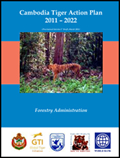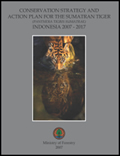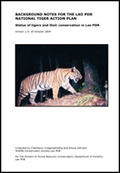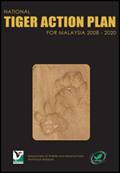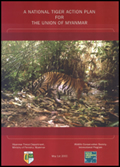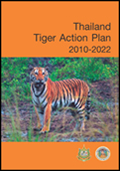
TOP > 生物多様性センターの国際協力 > ESABII > Database > Others > Tiger

Tiger

The cat group, Carnivora Felidae, consists of three major lineages, the ocelot lineage in South America, the domestic cat lineage, and the tiger lineage in Africa and Asia. The tiger lineage includes four members of the Panthera genus of large cat, the lion, leopard, snow leopard, and tiger (Panthera tigris). The tiger is one of the keystone species in forest ecosystems and has been respected for its power and attractive figure. The tiger is also used as a symbol in flags and figurines, however, tigers are traditionally considered pest animals because they sometimes attack humans and livestock. The mitigation of tiger-human conflicts and the protection of humans are major issues for tiger conservation and management besides the prevention of illegal hunting and the conservation/restoration of tiger habitats.
TAXONOMY
The tiger species (Panthera tigris) was confirmed as having 9 extant or extinct subspecies as follows.
- Amur Tiger: Panthera tigris ssp. altaica (Temminck, 1844),? EN in the IUCN Red List
- South China Tiger: Panthera tigris ssp. amoyensis (Hilzheimer, 1905),? CR in the IUCN Red List
- Bali Tiger: Panthera tigris ssp. balica (Schwarz, 1912),? EX in the IUCN Red List
- Indochinese Tiger: Panthera tigris ssp. Corbetti (Mazak, 1968),? EN in the IUCN Red List
- Malayan Tiger: Panthera tigris ssp. jacksoni (Luo et al., 2004),? EN in the IUCN Red List
- Javan Tiger: Panthera tigris ssp. sondaica (Temminck, 1844),? EX in the IUCN Red List
- Sumatran Tiger: Panthera tigris ssp. sumatrae (Pocock, 1929),? CR in the IUCN Red List
- Bengal Tiger: Panthera tigris ssp. tigris (Linnaeus, 1758),? EN in the IUCN Red List
- Caspian Tiger: Panthera tigris ssp. virgata (Illiger, 1815),? EX in the IUCN Red List (Genetic analysis ofmuseum skins indicate a close relationship with the Amur Tiger P. t. altaica)
HABITAT

The tiger inhabits dense forest and mosaic forest habitats and open land including swamp habitats in Asia. The range of the distribution of tigers extends from the Russian Far East to western India and north-eastern Pakistan through to South-East Asia, including Sumatra. Dry lands, semi-dry lands and high mountain areas are not preferred by tigers, thus the highlands and desert areas of central Asia are not part of the range of tigers. Several subspecies have become extinct in their historical ranges; including the Kazakhstan area, the Java and Bali islands and large parts of south eastern China.
The availability of a sufficient prey base for large ungulates is the tiger's main habitat requirement. It is estimated that tigers need to kill 50 large prey animals per year. As a result, the tiger needs an extensive home range. The home range of tigers therefore depends on the abundance of its prey - e.g., the female home range in Chitwan averaged 20 km2, while in the Russian Far East the range is much larger at 450 km2 (Sunquist and Sunquist 2002).
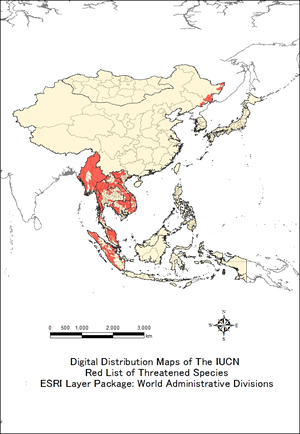
POPULATION
The world tiger population consisted of around 4,000 individuals in 2010 (mean estimation = 3,643 tigers, according to the Global Tiger Initiative, GTI). The Sundarban region in Bangladesh is believed to maintain the largest population of 300-500 tigers in a single habitat in the world. According to the GTI statistics the size of the various national tiger populations is estimated as follows in the ESABII member countries. (htt://www.globaltigerinitiative.org)
- Cambodia: 10-50 adult tigers (source: 2009 IUCN Red List); 10-30 (source: GTI)
- China: 40-50 adult tigers (source: 2009 IUCN Red List); 45 (source: GTI)
- Indonesia: 450-700 adult tigers (source: 2009 IUCN Red List); 250-400 (source: GTI)
- Laos: 9-23 (source: GTI)
- Malaysia: 300-500 adult tigers (source: 2009 IUCN Red List); 500 (source: GTI)
- Myanmar: 85 (source: GTI)
- Thailand: about 100 adult tigers (source: 2009 IUCN Red List); 200 (source: GTI)
- Vietnam: Less than 100 adult tigers (source: 2009 IUCN Red List); 10s (source: GTI)
The size of the total population of tigers in the ESABII member countries is 1,000-1,600 adult tigers based on a simple calculation.

Both the population and the habitat of tigers have been declining over the a past few centuries. The main causes of the decline in the tiger population are (1) habitat loss, (2) depletion of prey animals, (3) illegal hunting, and (4) management removal of problem individuals. The loss of tiger habitat has occurred in large parts of their original range as land use has changed from forest to agricultural land and plantations. As for prey animals, tigers prefer large to medium-sized herbivores, which have declined in number due to hunting and habitat loss. People have also killed tigers as a symbolic animal for big game hunting. Tigers were also hunted for their products; the skin, meat, bones used as tonics as well as in local traditional medicines. The removal of tigers for population management has been conducted for a long time to protect human life. The rise in the human population and the expansion of the area for human dwellings have increased tiger-human conflicts and thus the management removal of tigers.
INTERNATIONAL CONSERVATION
Tigers, along with other large Asian cats, have been included in Appendix I of CITES since 1975 (the Amur tiger was listed in 1977). Tigers, including 9 sub-species, have been classified as endangered species in the IUCN Red List since 1986.
The Global Tiger Initiative (GTI) was launched in 2008 as an alliance of 13 countries, international organizations and civil society organizations with the support of the World Bank. Cambodia, China, Indonesia, Lao PDR, Malaysia, Myanmar, Thailand and Vietnam are the GTI core partners in the ESABII member countries.
In 2010, the Year of the Tiger on the Asian lunar calendar, tigers were the focus of substantial conservation efforts and investment. At a “Tiger Summit” held in St. Petersburg, Russia, in November 2010, the 13 Tiger Range Countries adopted a Global Tiger Recovery Program (GTRP 2010). GTRP’s goal is to effectively double the number of wild Tigers by 2022
For more Information about the Global Tiger Initiative (GTI) ?Click HERE!
LOCAL CONSERVATION (National Action Plans)
CAMBODIA (Cambodia Tiger Action Plan 2011-2022 (Forestry Administration)
The tiger is fully protected by the Cambodia Wildlife Protection Act, 2007. Moreover, the Forestry Law, 2002 prohibits hunting, killing, trading or exporting of tigers. Only a few scattered individual tigers remain in Cambodia. The Cambodia tiger action plan focuses on environmental education, upgrading of local community livelihoods, participatory land use planning, sustainable funding for community, research and surveys, law enforcement, etc.
For more Information Click HERE!
CHINA (China Action Plan for Saving the South China Tiger (National Zoo))
The South China Tiger (Panthera tigris amoyensis) is the most endangered tiger subspecies in the world. The total population size is estimated at 30 to 80 tigers in the wild. The captive population of tigers in Chinese zoos increased from 51 in 1995 to 62 by June 2000. The potential distribution area of these tigers is estimated to be up to 90,000 km2. The Chinese government has executed tiger protection laws, habitat conservation regulations, a ban on tiger products and public education. Government organizations have also conducted the transfer of isolated roaming individual tigers and the reintroduction of captive-bred tigers into the wild. Amur tiger conservation in China is not mentioned in the action plan.
For more Information Click HERE!
INDONESIA (Conservation Strategy and Action Plan for the Sumatran Tiger (Panthera tigris sumatrae) Indonesia 2007 ? 2017 (Ministry of Forestry)
The population of the Sumatran tiger is estimated at just 400 animals in 5 national parks and 100 animals outside protected areas according to a study in 1992 and the population has continued to decline. According to recent studies, the Sumatran tiger population currently extends over at least 18 conservation areas and in both protected forests and production forests it is estimated at around 256-324 animals that are physically separate from one another. Increasing human encroachment into tiger habitats is the major threat to the Sumatran tiger, especially as humans continue to use forests for economic development purposes such as agriculture and mining, as well as for other infrastructure
development as a result of settlement and transmigration. Besides causing habitat fragmentation, such activities often lead to conflicts between humans and tigers, resulting in victims on both sides, and finally driving the tiger from its habitat. The action plan recommends (1) development of a management strategy for the conservation of the Sumatran tigers, (2) Preservation and protection of the existing Sumatran tiger population in its natural habitat, (3) Institution of breeding initiatives to help the tiger population recover in its natural habitat, (4) Development of a working network to support Sumatran tiger conservation in Indonesia.
For more Information Click HERE!
LAO, PDR (Background notes for the Lao PDR National Tiger Action Plan (Wildlife Conservation Society ? Lao PDR for the Department of Forestry Lao, PDR)
Tiger studies in Lao PDR were conducted using camera traps and scat DNA analysis from 2005, in class I, class II, class III forests, and the potential landscapes distinguished from their habitat status. Concrete data for a population estimation is not mentioned in the background note. Laos has an advantage with regard to tiger conservation since it has a low human population density compared to other Asian countries, a high proportion of forest cover, a well-developed protected area system and the existence of key prey. However, Laos also has constraints in terms of the lack of base line data on the tigers and their prey, weak law enforcement, and limited human resources and financial support for animal conservation. The goal of tiger conservation in Lao PDR is to recover and maintain viable populations of tigers and their prey in all the existing tiger conservation landscapes across the country.
For more Information Click HERE!
MALAYSIA (National Tiger Action Plan for Malaysia 2008-2020 (Department of Wildlife and National Parks, Peninsular Malaysia)
Tigers only inhabit? Peninsula Malaysia (mainland) and are not present in the Eastern Malaysia region of Borneo. The main landscape (20,000 km2) of the tiger’s range in the western part of the mainland runs from the Malaysia-Thai border to Negeri Sembilan, connecting to the Taman Negara National Park. The southern part of the mainland is another isolated habitat (10,000 km2) for tiger. The Action Plan has targeted an increase in the harimau belang (Malayan tiger) population from 500 in 2007 to 1,000 by 2020 in their natural habitat. Developing the Malaysian Conservation Alliance for Tigers (MYCAT) and ensuring the connectivity of habitats are priority activities in the action plan and other goals concern decreasing human tiger conflicts (HTC), issues of the translocation of problem tigers and relief funds for the victims.
For more Information Click HERE!
MYANMAR (A National Tiger Action Plan for the Union of Myanmar (Ministry of Forestry)
A series of 17 potential tiger habitats was identified from large blocks of forest through a tiger study in 1999 in Myanmar. No more than 150 wild tigers are now probably in the wild in Myanmar (1999 study), but the population has rapidly declined compared to the estimation of 600 to 1,000 tigers in a study in 1996. The status of tigers in the Myanmar-Thailand border is not clear. Priority actions for conservation in the short term are the establishment of protected areas, a monitoring programme, reduction in the killing of tiger prey species, and suppressing illegal hunting.
For more Information Click HERE!
THAILAND (Thailand Tiger Action Plan 2010-2022 (Ministry of Natural Resources and Environment)
Although tigers in Thailand face similar threats to those in other countries where they exist, tigers still occur in several parts of the country. The largest population of tigers in Thailand occurs in one area near the Thailand-Myanmar border, called the Western Forest Complex. A recent country-wide survey of tigers have revealed that they occur at very low densities in other parts of the country. According to camera trap surveys from 2008 and 2009, it is estimated that there are likely to be 190-250 tigers remaining in Thailand. There are five Priority Action as follows;
1) Strengthening direct conservation action and enforcement
2) Building capacity based on successful models
3) Strengthening monitoring, research, and information management
4) Promoting education, awareness, and public participation
5) Strategic financing for tiger conservation.
For more Information Click HERE!
VIETNAM (National Action Plan on Tiger Conservation in Vietnam (Song Thanh Nature Reserve)
The tiger population in Vietnam declined rapidly from 3,000 individuals in 1960 to around 100 individuals in fragmented habitat along the Truong Son mountain range and West Plateau in 2004. The main objective of the National Tiger Action Plan is to identify suitable habitats to recover the tiger prey population and maintain these tiger habitats, establish tiger landscapes and a monitoring system and improve cross-border conservation cooperation with Lao PDR and Cambodia for tiger conservation.

